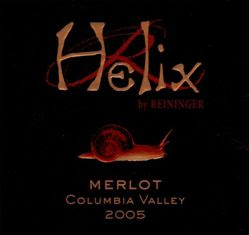
The Walla Walla stalwart
L'Ecole No. 41 is no stranger to 90+ point wine ratings in the established wine mags. So I was particularly happy to find their
2004 Columbia Valley Merlot, an 89 point score proudly displayed below it on the wine store shelf.
How does a winery that's often the darling of established wine mags. sink below the "90" threshold?
Probably because
it scored 89 at Wine Spectator... and a 90 nearly everywhere else!
Now, that one is just
too good to pass up for the
89 Project, right?
It might also explain why they thought they could get away with charging well over $20 per bottle on this sucker...
Anyway, the
L'Ecole No. 41 2004 Columbia Valley Merlot just qualifies as a single-varietal labeling, being 80% Merlot, 12% Cabernet Franc, 6% Cabernet Sauvignon, and 2% Petit Verdot (presumably for good measure).
What I liked most about the big mag. reviews on this wine is
how similar they all are. You tell me - which one do
you think is the 89-pointer review:
1) "
This is a classy, sophisticated wine, blended from a wide range of Washington vineyards. It’s really a Right Bank-styled Bordeaux blend. Berries and spice, chocolate and herb, and many other lightly applied nuances make this a pleasure to sip."
2) "
Crisp in texture and generous in flavor, offering currant and blackberry fruit that’s shaded with herbal notes as the finish lingers. Drink now through 2008."
3) "
Deep garnet color with a brick rim. Dark chocolate covered fruit, mocha, and roasted nut aromas. A round entry leads to a dry-yet-fruity medium-full bodied palate with baked plum, baker’s chocolate, and spicy, mocha flavors. Finishes with a long, toasty oak and fresh plum skin fade."
Yeah, I thought so.
Kind of helps to prove one of the points of the 89 Project, right?
Somehow, WS decided to dip below the 90 mark when reviewing this wine. Why? To start answering that question, I'll offer my take on this wine:
It's almost Zin-level big and jammy. One whiff, and you know that you boarded the bus to "over 14% abv land" so if that's not your ticket, you'd better get off now. Blueberry and blackberry aromas jump up at you from the glass. When I say jump up at you, I mean like "two house pets greeting you at the door" jump up.
"Ohhh! Oh! Me first! Me FIRST!"
"Noooo! ME! Pet ME FIRST!!!"
It's not a coordinated effort.
The finish has herbs on it, for sure, but they are aflame in the unmistakable astringency of booziness.
It's not a bad wine by any stretch, but it's a total brute of Merlot, and you need to be in the mood for that.
This could be one instance where I actually *agree* with Wine Spectator (a rare occasion indeed), if the intent of dropping below 90 points was to give this wine a level of separation from more refined Merlot offerings. Theirs was the 2nd review, by the way.
File this one in the "
pretty good, but I expected a bit more from you guys" category.
Cheers!
 label, Reininger sources fruit from the larger Columbia Valley. This allows Reininger to increase production and expand distribution. This also allows the Reininger label to continue to maintain a limited production. The Reininger label is produced with fruit that is sourced from only the Walla Walla Valley. Helix can target a new group of wine lovers while keeping costs down. When I discovered the Helix Merlot - 2005 received a 89 from the Wine Enthusiast, I had to wonder why? Is it because of a second label thinking it should not be as good or is the real problem here - - another Merlot? I also thought about those "pointy people" who walk into a winery or wine store only wanting to buy 90+ scored wine, and often without tasting. What wines do they drink for every day sipping and especially when their pointy-friends are not around? Do they drink costly 90+ scored wines? Perhaps they are secret 89 secret sippers when nobody is looking.
label, Reininger sources fruit from the larger Columbia Valley. This allows Reininger to increase production and expand distribution. This also allows the Reininger label to continue to maintain a limited production. The Reininger label is produced with fruit that is sourced from only the Walla Walla Valley. Helix can target a new group of wine lovers while keeping costs down. When I discovered the Helix Merlot - 2005 received a 89 from the Wine Enthusiast, I had to wonder why? Is it because of a second label thinking it should not be as good or is the real problem here - - another Merlot? I also thought about those "pointy people" who walk into a winery or wine store only wanting to buy 90+ scored wine, and often without tasting. What wines do they drink for every day sipping and especially when their pointy-friends are not around? Do they drink costly 90+ scored wines? Perhaps they are secret 89 secret sippers when nobody is looking.









